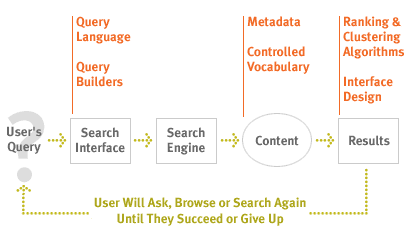Jared Spool loves to slander search. He says “searching stinks.” He proclaims it’s “worse than nothing.” He exhorts web designers to “keep users from using search.” And he backs up these defamatory accusations with $3,000,000 worth of user research data. Is Jared right? Do his research results tell the whole truth and nothing but the truth? Is browsing better than searching? No, No, and No!
Gross Generalizations
My quarrel is not with Jared’s results but with his conclusions. I too have seen users fail miserably in their attempts to find content using web site and intranet search engines. There’s no doubt that the implementation of search on many sites actually does stink.
But to draw the general conclusion that search is an ineffective tool from these specific observations of existing e-commerce web sites is like eating a frozen egg roll and declaring that all Chinese food is bad.
Injurious Impact
What I’m most concerned about is the impact of Jared’s proclamations. He urges designers to focus attention on improving the site’s category links. This is a good thing and I’m glad his research illuminates the critical importance of information architecture design to overall usability!
However, to encourage taxonomy design at the expense of search system design is a bad message to be sending in today’s web environment.
Investment in search system design is already absurdly low. In my consulting engagements, I see organizations of all shapes and sizes investing heavily in taxonomy design while giving almost no thought to the search system.
Why? Because taxonomy design is the current rage. Because many people don’t understand how search can be improved. Because search engine configuration is often “owned” by the IT group rather than by the folks responsible for design, usability and information architecture. And because Jared keeps slamming search.
The pendulum needs to swing back the other way. Many web sites and intranets can benefit most dramatically and immediately from enhancements to the search system. We’re talking major ROI here. Lots of return with relatively little investment.
Search is Essential
It’s simply a matter of size. Small sites don’t need search. Big ones do. An e-commerce site with 100 products may be able to get by without search. A large, complex web site or intranet with 10,000 or 100,000 documents and applications will require search for a significant percentage of users and tasks.
A taxonomy can only do so much. Any hierarchy is ultimately subject to the depth/breadth tradeoff, the ambiguity of language, and the limits of human cognition.
So unless you’re running a tiny web site or intranet, you have no choice in the matter. You must buy a search engine and your users will use it.
Search is a System
But a search engine is not enough! Designers need to take a systemic approach that recognizes the roles played by the search interface, the content and the results presentation.

If your site is bloated with ROT (Redundant, Outdated or Trivial content), search results will suffer. If your ranking algorithm buries the most relevant results, users will fail to find them. Like many other complex systems, search is only as good as its weakest link.
And we need to design for the iterative, interactive nature of users’ information seeking behavior, recognizing that people need to move fluidly between searching, browsing and asking modes.
Search is Multifarious
How can Jared universally castigate search when there are so many unique approaches ranging from the mundane to the exotic?
- By matching search interface design with faceted classification, we can support parametric searching.
- By studying search logs and identifying business priorities, we can feature best bets in our results display.
- By developing controlled vocabularies, we can manage the synonym problem.
- By combining natural language parsing and human-created knowledge-bases we can provide interactive agents.
- By tracking link references or user behavior we can tap into the adaptive power of collaborative filtering.
- By leveraging category structures, we can provide results in context.
These are just some of the tools and techniques we need to explore and evaluate before deep-sixing search.
Search Sucks
But not in a bad way! Search sucks tremendously valuable data about your users into your organization. The smartest companies are aggressively mining their search logs, learning what their customers want and how they describe these needs in their own words.
Web groups have been using this data for years to inform taxonomy design, controlled vocabulary development and the selection of “best bets.” Increasingly, other groups such as marketing and research are beginning to recognize it as a timely source of information about customer preferences and industry trends.
Long Live Search
I really don’t have anything against Jared Spool and I don’t own a bunch of stock in a search engine vendor. I simply see search as a hugely under-developed component of many web sites and intranets.
Yes, search has been pathetically implemented on countless sites. Yes, search is an easy target. But that’s exactly why I wish Jared would stop kicking this poor, shivering underdog.
It may look ugly right now. It may even have a few fleas. But it’s got great potential. Long live search!
by Peter Morville